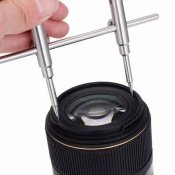The question is.. Is this dust or is is an early stage of schneideritis? (Im talking about the three white dots)
IMO not dust and not schneideritis...
Schneideritis happens in the cylinder, but those dots are in the flange. If you unscreew the retaining ring with an spanner tool

then probably you may remove the first glass. The first glass lays between the retaining ring and a flange, that flange has those scratches or dust particles.
Schneideritis is another thing, here it's well described:
https://richardhaw.com/2016/11/12/repair-shneideritis-edge-separation/
A possibility is that the front element was removed at some point to clean the inner surfaces, as with time they can accumulate some dirt. Changes in atmospheric pressure and geographic altitude may make air enter and exit, over time this unfiltered air and micro condensation may build a layer of dirt provocating some internal haze. In that cleaning operation perhaps those spots were provocated. This would not be bad news, meaning is that this lens was properly serviced.
Another reason to remove the external element could have been making a new lens from two destroyed lenses, some ebay sellers may do that, they may take the inner group of a lens having a hit in the external element and the external element of a lens having fungus in the internal group, so they have cell without evident flaws. Such a frankentein lens may not perform optimally because the elements were not optimally combined and/or shimming was not optimal, but this has a very low probability if the seller had a good reputation.
Probably your lens is totally excellent, and of course those spots won't have any impact in the image, absolutely.
A concern with many rodenstock models (and other) is if the shimming of the lens is optimal. In several models shims could be placed for the front cell to optimally adjust inter-cell distance for that particular unit. A unit of a model "with shims" could incorporate one shim, several shims or none. The concern is that those shims have to be moved to a new shutter if the original was broken. Shutters were made with a tight tolerance and probably there is no need to adjust the shimming again when shutter is replaced, but some users or some repair shops are able to lose the shims...
You may check if your lens has a reasonable good shimming by checking if corner sharpness improves noticeably as you unscreew the front cell some 1mm or 2mm, while you keep the center in optimal focus. If the image cannot be improved then probably your shimming is good enough.





